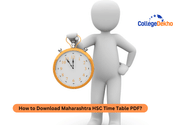

Never Miss an Exam Update
ISC Class 12 Economics Syllabus 2025-26 is available on the official website at cisceboard.org. The syllabus is structured into six chapters and 2 parts. Part I (20 marks) consists of compulsory short answer questions testing knowledge, application, and skills relating to elementary/fundamental aspects of the entire syllabus. Part II (60 marks) consists of eight questions, out of which candidates are required to answer five questions, each carrying 12 marks. The syllabus also specifies the marks distribution for each topic, allowing students to prioritize their preparation based on the weightage of each section. The ISC Class 12 Economics examination is expected to be held in February 2026 in offline mode. The theory exam will be conducted for 80 marks, along with the 20-mark Internal Assessment, bringing the total to 100 marks. Check the detailed ISC 12th Economics Syllabus 2025-26 here.
Also Read
ISC 12th Time Table 2025-26
ISC Class 12 Economics Syllabus 2025-26 PDF
The ISC Class 12 Economics syllabus for the 2025-26 academic year is now available on the official website. Students are encouraged to refer to the updated syllabus to familiarize themselves with the chapter-wise exam pattern and optimize their preparation for achieving higher grades in the upcoming board exams.
| ISC Class 12 Economics Syllabus 2025-26 PDF |
|---|
ISC Class 12 Economics Course Structure 2026
Microeconomics
- Demand
- Elasticity of Demand
- Supply
- Market Mechanism
- Concepts of Production
- Cost and Revenue
- Main Market Forms and Equilibrium of a Firm
Macroeconomics
- Theory of Income and Employment
- Money and Banking
- Balance of Payment and Exchange Rate
- Public Finance
- National Income
ISC Class 12 Economics Syllabus 2025-26
Students can check the detailed syllabus for the Economics subject from the table given below and start their preparations for the ISC Class 12 Board Exams 2025-26:
| Chapters | Topics | Weightage |
|---|---|---|
| Chapter 1 - Microeconomic Theory |
(i) Demand: meaning, factors affecting demand; Demand function; Law of Demand; derivation of demand curve; movement and shift of the demand curve; exceptions to the Law of Demand. Law of Diminishing Marginal Utility, Law of Equimarginal Utility, consumer’s equilibrium through utility approach (Cardinal) and indifference curve analysis (Ordinal). The concept of demand: meaning, types of demand. A demand function is to be specified, incorporating the determinants of demand. Diagrams should be used in explaining the Law of Demand, the reasons for the downward slope of the demand curve, its derivation using the demand schedule. Derivation of market demand curve from individual demand curve.
(ii) Elasticity of demand: meaning, types of elasticity of demand, measurement of elasticity of demand; factors affecting elasticity of demand. (iii) Supply: meaning; difference between stock and supply; determinants of supply; Law of Supply; movement and shift of the supply curve; elasticity of supply. (iv) Market Mechanism: Equilibrium and disequilibrium; Equilibrium price and effect of changes in demand and supply on the equilibrium price. Simple applications of tools of demand and supply. (v) Concept of production and production function: (short run and long run production function), returns to a factor, returns to scale (meaning only) total, average and marginal physical products; Law of Variable Proportions and its three stages. (vi) Cost and revenue: Basic concepts of cost; fixed cost, variable cost, total cost, marginal cost and average cost – their relationships; opportunity cost; short run and long run cost curves. Revenue: meaning; average revenue, marginal revenue and total revenue and their relationships under perfect competition and imperfect competition, Producer’s equilibrium. Basic concept. (vii) Main market forms: perfect competition, monopolistic competition, oligopoly, monopoly, monopsony; characteristics of the various market forms; equilibrium of a firm in perfect competition under short run and long run. | 48 marks |
| 2. Theory of Income and Employment | Basic concepts and determination of Income and Employment The concept of demand (exante) and effective (expost) demand. Aggregate demand and its components, propensity to consume and propensity to save (average and marginal), equilibrium output; investment multiplier (its meaning and mechanism with the help of a diagram). Simple numerical based on the above. Meaning of full employment. Problems of excess demand and deficient demand; measures to correct them. | 8 marks |
| 3. Money and Banking |
(i) Money: meaning, functions of money, supply of money. Meaning, kinds of money, functions of money (primary, secondary and contingent) to be explained; supply of money (only meaning of M0, M1, M2, M3 & M4). Inflation: meaning, demand pull and cost push (diagrams not required).
(ii) Banks: functions of commercial bank; high-powered money, credit creation by commercial banks; Central Bank: functions. Basic understanding of the functions of commercial banks, the credit creation process, with limitations. The regulatory role of the Central Bank, its functions and the way it controls the flow of credit needs to be explained. A brief mention may be made of quantitative CRR, SLR, Bank Rate policy (repo rate and reverse repo rate) and Open Market Operations) and qualitative methods | 8 marks |
| 4. Balance of Payment and Exchange Rate |
Balance of Payment – meaning, components; foreign exchange – meaning, determination of exchange rate (Flexible).
Balance of Payment - Meaning and components; Causes of disequilibrium and how the disequilibrium can be corrected; Foreign Exchange Rate – meaning, meaning of fixed and flexible exchange rate, determination of exchange rate in a free market. Concepts of depreciation, appreciation, devaluation and revaluation (meaning only). | 6 marks |
| 5. Public Finance |
(i) Fiscal Policy: meaning and instruments of fiscal policy. Meaning and instruments of fiscal policy – Public Revenue: Meaning, taxes (Meaning and types), difference between direct and indirect taxes; Public Expenditure: Meaning 107 and importance; Public Debt: Meaning and redemption; Deficit Financing: meaning.
(ii) Government Budget: meaning, types and components. Meaning and types of Government budget – union, state; components – revenue and capital. Concept of deficit budget: revenue deficit, fiscal deficit, primary deficit – their meaning and implications. | 6 marks |
| 6. National Income |
(i) Circular flow of Income. A simple model explaining the circular flow of income with two, three and four sector models with leakages and injections.
(ii) Concepts and definition of NY, GNP, GDP, NNP, private income, personal income, personal disposable income, National Disposable Income and per capita income; relationship between the income concepts. A brief understanding of the mentioned national income aggregates is needed. The concepts of GNP and NNP should be explained both at factor cost and market prices, real GDP and nominal GDP, National Disposable Income (Gross and Net), GDP and Welfare, GDP as an indicator of Economic welfare. (iii) Methods of measuring National Income: product or value-added method; income method and expenditure method with simple numericals based on them. Simple numericals based on all the methods to be covered for better understanding of the concept. Precautions and difficulties of measuring National Income for each method. | 12 marks |
ISC Class 12 Economics Practical Exam Syllabus 2025-26
ISC Class 12 Economics is divided into theory and practical exams. 20 marks are reserved for the practical exam. The students will have to prepare for 2 projects, each of which will carry 10 marks. One project will be checked by the subject faculty and the other project will be checked by the external faculty. The marks will be distributed for various factors. Check the table below to understand the bifurcation of marks.
Overall Format | 1 mark |
|---|---|
Content | 4 marks |
Findings | 2 marks |
Viva-voce based on the project | 3 marks |
How To Download ISC Class 12 Economics Syllabus 2025-26?
There is a very easy procedure through which the students can download the ISC Class 12 Economics Syllabus 2025-26. Check the sample procedure from the pointers given below:
- Step 1: You will first have to visit the official website of CISC at cisc.org
- Step 2: On the homepage, you have to click on the Examinations option present on the menu bar.
- Step 3: From the drop-down menu, click on ISC Examination.
- Step 4: On the new page, you have to scroll down and click on Regulations And Syllabuses.
- Step 5: Now, click on the option called Regulations And Syllabus - ISC 2025
- Step 6: The list of syllabi will open on your screen. You have to click on Economics to download the PDF.
Best Reference Books for ISC Class 12 2026
Following is the list of recommended books for Economics.
- Understanding I.S.C. Economics Class- XII. B.L. Gupta
- Frank ISC Economics for Class 12 (Revised According to the Syllabus for and after the year 2025) DK Sethi.
- T.S. Grewal's Double Entry Book Keeping (Section A): Textbook for ISC Class 12 (2025-26 Examination) T.S. Grewal.
- Frank ISC Economics for Class 12 (Revised According to the Syllabus for and after the year 2025)
ISC Class 12 Economics Syllabus 2025-26 is listed on the official website of CISCE to be downloaded by the students. Download the PDF to start your preparations.
Are you feeling lost and unsure about what career path to take after completing 12th standard?
Say goodbye to confusion and hello to a bright future!

FAQs
To complete the ISC Class 12 Economics Syllabus 2025-26, students might need to study it throughout the academic year. At the end of the preparation, students can focus on practicing sample papers. Try to keep two months aside for revision.
ISC Class 12 Economics Paper 2025-26 will be divided into two parts. Part one will have compulsory short-answer questions of 20 marks overall. Part 2 will be for 60 marks but it will consist of 8 questions out of which students are required to answer 5 questions, each carrying 12 marks.
Yes, ISC Class 12 Economics Syllabus 2025-26 is uploaded on the official website of CISCE. The organisation has released the latest information about the syllabus for each subject on the official website.
ISC Class 12 Economics Syllabus 2025-26 is now listed on the official website of CISCE to be downloaded by the students. The students can go to the official website at cisce.org and click on the Examination option present on the menu bar to download the syllabus.n
ISC Class 12 Economics Syllabus 2025-26 is divided into Microeconomics and Macroeconomics. Both parts have 7 and 5 chapters, respectively.
Was this article helpful?




















